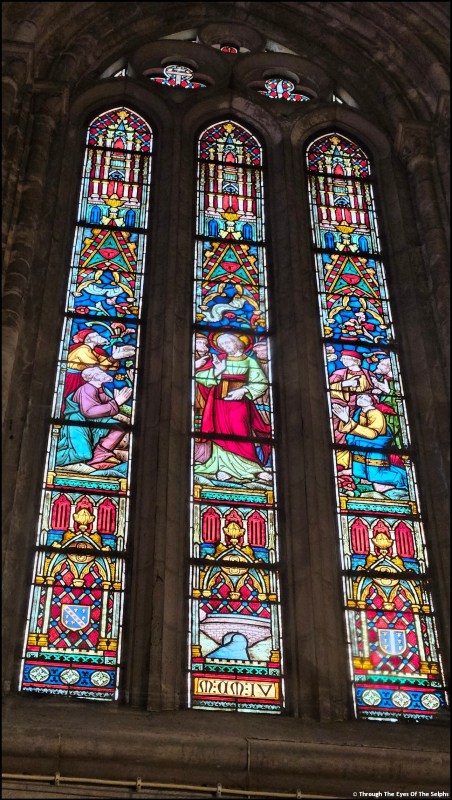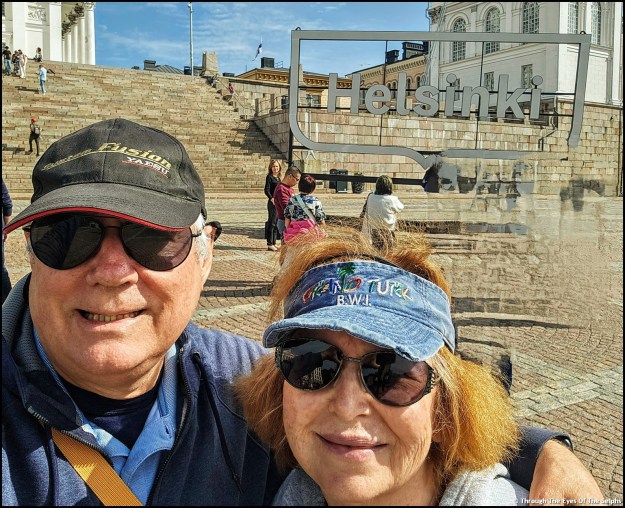Overnight we traveled on the Amazon River toward Santarem and eventually the Atlantic Ocean. This picture (provided by our ship) shows how the Amazon River is not straight.
On January 16th we stopped at Santarem, our last port of call in Brazil. This was our fifth port in a row and once again this was a tender boat port. The tender boat drivers have really had a busy week! I think everyone is looking forward to the sea days coming up next. Especially since the clocks went ahead one hour and we lost an hour of sleep. 
This view (provided by our ship) shows the confluence of the Amazon and the Topajos Rivers at Santarem, Brazil.
We booked our first excursion of the cruise, “Highlights of Santarem”. We were glad to be doing more bus touring today and less walking. The extreme heat has been hard on us.
Santarem (pop 300,000) was founded in 1661 and was originally called “New Santarem”. It is one of the oldest cities in the Brazilian Amazon. At one time the economy revolved around timber, rubber, coffee and gold mining. Today the main economy is soybean cultivation and lumber. 
Our tour group met at 8:45 and together we took a tender boat on the thirty minute ride to shore while the ship remained docked offshore in deeper water.
We had an excellent tour guide whose enthusiasm to share his city with us really wore everyone out. The extreme heat sure didn’t help. The three and a half hour excursion ended up being four and a half hours. We really got our money worth.
In Brazil the “tour buses” are really more like school buses or city buses with no AC. Since everything we saw was outside, there was no escaping the heat.
Our guide understood and spoke English with a heavy accent but he was still easy to understand.
Our first stop was at a rubber tree and flour farm. First a local man showed us how rubber is extracted from the rubber tree.

We then walked briefly through a rainforest area where he pointed out mango trees and trees with Brazil nuts, among many others.
We then walked to another area where several locals demonstrated how they made a type of flour that is used to make many dishes, including tapioca. 



Next was an area with many local fruits and Brazil nuts which were identified and samples were offered. We passed on any samples. They demonstrated how hard it is to crack a Brazil shell and showed how one shell can have over twenty individual nuts inside. 

We then were driven to a couple markets where we were shown many items that were natural products that are good for many health problems. Surprisingly we were not given time to shop which is often the case. We were then taken to another open air market with fresh meat products, especially many kinds of fish.

Amazing to see all fresh fish displayed in all the heat. Shrimp was piled up without any ice.
Back on the bus to see the cathedral. Our guide gave us a nice detailed tour of the cathedral. It was surprising because usually tour guides take you to cathedrals and wait while you wander around. Our great guide proudly gave us a great tour of the cathedral. We were told that just 60% of the people were Catholic. 



This statue has human hair that is replaced yearly.
By this time we were wilting, but there was more! We stopped at an overlook where the Amazon River converges with the Tapajos River.
By this time we were hot, tired and hungry. Just when we thought we couldn’t take more, the guide told us we had one final stop. A municipal museum where he led us through several rooms with the history of Santarem. By this time our eyes had glazed over and I wondered which of us was going to be the first to pass out from a heat stroke. 
As much as we enjoyed and appreciated our guide, it was truly a relief to arrive back to the pier to catch our tender boat.
On the bus ride back to the pier our tour guide had five prizes to hand out to people that could answer questions from what he told us today. I correctly answered a question and won a cute little souvenir made from a Brazil nut with a little figure of a toucan inside and the name “Santarem” painted on the front. I had to turn it into security when we boarded the ship so it could be put in the deep freeze for a couple days to kill any insects. They later delivered it to our cabin.
That afternoon we began the final leg of our trip on the Amazon River. Tomorrow we will once again cross the equator as we make our way back to the Atlantic Ocean. From our balcony during the sail away we passed the convergence of the two rivers, giving us a great view. 


Some thoughts on our time cruising the Amazon River. We were surprised we didn’t see any other cruise ships or pleasure boats on the river. All the boat traffic were barges and freighter, etc. At each of the five ports, we were the only cruise ship. We came to realize that this part of the world is isolated and takes some time to cruise the river. Therefore only cruise ships with longer itineraries make this voyage. It seems only around twelve cruise ships make this trip each year. Perhaps that is why we often saw little rowboats come up alongside the ship and take pictures. The funny thing is they were taking pictures of us and at the same time we were taking pictures of them.
We were surprised to see the muddy color which eventually as we traveled further down the river became more of a blue green color. We were also surprised to all the logs, trees, branches, plants and debris being carried in the swift current. Between that and the narrow, shallow places to navigate, it is no surprise that we had Brazilian navigators/pilots onboard the entire eight days. Our tour guide in Santarem told us this area is having a severe drought. 
Next up: A final Brazil show and what happens on a sea day













































































































































































